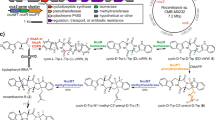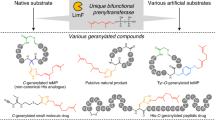Abstract
The anti-oxidant naphterpin is a natural product containing a polyketide-based aromatic core with an attached 10-carbon geranyl group derived from isoprenoid (terpene) metabolism1,2,3. Hybrid natural products such as naphterpin that contain 5-carbon (dimethylallyl), 10-carbon (geranyl) or 15-carbon (farnesyl) isoprenoid chains possess biological activities distinct from their non-prenylated aromatic precursors4. These hybrid natural products represent new anti-microbial, anti-oxidant, anti-inflammatory, anti-viral and anti-cancer compounds. A small number of aromatic prenyltransferases (PTases) responsible for prenyl group attachment have only recently been isolated and characterized5,6. Here we report the gene identification, biochemical characterization and high-resolution X-ray crystal structures of an architecturally novel aromatic PTase, Orf2 from Streptomyces sp. strain CL190, with substrates and substrate analogues bound. In vivo, Orf2 attaches a geranyl group to a 1,3,6,8-tetrahydroxynaphthalene-derived polyketide during naphterpin biosynthesis. In vitro, Orf2 catalyses carbon–carbon-based and carbon–oxygen-based prenylation of a diverse collection of hydroxyl-containing aromatic acceptors of synthetic, microbial and plant origin. These crystal structures, coupled with in vitro assays, provide a basis for understanding and potentially manipulating the regio-specific prenylation of aromatic small molecules using this structurally unique family of aromatic PTases.
This is a preview of subscription content, access via your institution
Access options
Subscribe to this journal
Receive 51 print issues and online access
$199.00 per year
only $3.90 per issue
Buy this article
- Purchase on Springer Link
- Instant access to full article PDF
Prices may be subject to local taxes which are calculated during checkout




Similar content being viewed by others
References
Shin-ya, K. et al. Isolation and structural elucidation of an antioxidative agent, naphterpin. J. Antibiot. (Tokyo) 43, 444–447 (1990)
Shin-ya, K. et al. Biosynthetic studies of naphterpin, a terpenoid metabolite of. Streptomyces. Tetrahedr. Lett. 31, 6025–6026 (1990)
Seto, H., Watanabe, H. & Furihata, K. Simultaneous operation of the mevalonate and non-mevalonate pathways in the biosynthesis of isopentenyl diphosphate in Streptomyces aeriouvifer. Tetrahedr. Lett. 37, 7979–7982 (1996)
Botta, B. et al. Prenylated flavonoids: pharmacology and biotechnology. Curr. Med. Chem. 12, 717–739 (2005)
Pojer, F. et al. CloQ, a prenyltransferase involved in clorobiocin biosynthesis. Proc. Natl Acad. Sci. USA 100, 2316–2321 (2003)
Edwards, D. J. & Gerwick, W. H. Lyngbyatoxin biosynthesis: sequence of biosynthetic gene cluster and identification of a novel aromatic prenyltransferase. J. Am. Chem. Soc. 126, 11432–11433 (2004)
Izumikawa, M. et al. Expression and characterization of the type III polyketide synthase 1,3,6,8-tetrahydroxynaphthalene synthase from Streptomyces coelicolor A3(2). J. Ind. Microbiol. Biotechnol. 30, 510–515 (2003)
Funa, N. et al. A new pathway for polyketide synthesis in microorganisms. Nature 400, 897–899 (1999)
Bruno, M. et al. New flavonoids from Bonannia-Graeca (L) halacsy. Heterocycles 23, 1147–1153 (1985)
Schutz, B. A. et al. Prenylated flavanones from leaves of Macaranga pleiostemona. Phytochemistry 40, 1273–1277 (1995)
Taura, F., Morimoto, S. & Shoyama, Y. Purification and characterization of cannabidiolic-acid synthase from Cannabis sativa L. Biochemical analysis of a novel enzyme that catalyzes the oxidocyclization of cannabigerolic acid to cannabidiolic acid. J. Biol. Chem. 271, 17411–17416 (1996)
Gerlt, J. A. & Raushel, F. M. Evolution of function in β/α8-barrel enzymes. Curr. Opin. Chem. Biol. 7, 252–264 (2003)
Sacchettini, J. C., Gordon, J. I. & Banaszak, L. J. Crystal structure of rat intestinal fatty-acid-binding protein. Refinement and analysis of the Escherichia coli-derived protein with bound palmitate. J. Mol. Biol. 208, 327–339 (1989)
Xu, Z., Bernlohr, D. A. & Banaszak, L. J. The adipocyte lipid-binding protein at 1.6 Å resolution. Crystal structures of the apoprotein and with bound saturated and unsaturated fatty acids. J. Biol. Chem. 268, 7874–7884 (1993)
Branden, C. I. & Tooze, J. Introduction to Protein Structure 2nd edn. (Garland, New York, 1999)
Park, H. W. et al. Crystal structure of protein farnesyltransferase at 2.25 angstrom resolution. Science 275, 1800–1804 (1997)
Long, S. B., Casey, P. J. & Beese, L. S. Reaction path of protein farnesyltransferase at atomic resolution. Nature 419, 645–650 (2002)
Koyama, T. et al. Identification of significant residues in the substrate binding site of Bacillus stearothermophilus farnesyl diphosphate synthase. Biochemistry 35, 9533–9538 (1996)
Kharel, Y. & Koyama, T. Molecular analysis of cis-prenyl chain elongating enzymes. Nat. Prod. Rep. 20, 111–118 (2003)
Liang, P. H., Ko, T. P. & Wang, A. H. Structure, mechanism and function of prenyltransferases. Eur. J. Biochem. 269, 3339–3354 (2002)
Tarshis, L. C. et al. Crystal structure of recombinant farnesyl diphosphate synthase at 2.6-Å resolution. Biochemistry 33, 10871–10877 (1994)
Cane, D. E. (ed.) Isoprenoids, Including Carotenoids and Steroids, in Comprehensive Natural Products Chemistry (Elsevier, London, 1998)
Jez, J. M. et al. Dissection of malonyl-coenzyme A decarboxylation from polyketide formation in the reaction mechanism of a plant polyketide synthase. Biochemistry 39, 890–902 (2000)
Doublie, S. Preparation of selenomethionyl proteins for phase determination. Methods Enzymol. 276, 523–530 (1997)
Otwinowski, Z. & Minor, W. Processing of X-ray diffraction data collected in oscillation mode. Methods Enzymol. 276, 307–326 (1997)
Terwilliger, T. C. Automated structure solution, density modification and model building. Acta Crystallogr. D 58, 1937–1940 (2002)
Jones, T. A., Zou, J. Y., Cowan, S. W. & Kjeldgaard, M. Improved methods for building protein models in electron density maps and the location of errors in these models. Acta Crystallogr. A 47, 110–119 (1991)
Brünger, A. T. et al. Crystallography & NMR system: A new software suite for macromolecular structure determination. Acta Crystallogr. D 54, 905–921 (1998)
Navaza, J. Implementation of molecular replacement in AMoRe. Acta Crystallogr. D 57, 1367–1372 (2001)
Acknowledgements
We thank F. Taura, S. Morimoto and Y. Shoyama for providing olivetol and olivetolic acid, as well as N. Funa and S. Horinouchi for the flaviolin sample. We also thank the staff of beamlines X8C and X6A at BNL, BL9.1 at SSRL and BM30A at ESRF. Work performed at SSRL was supported by grants from the National Institutes of Health, National Center for Research Resources, Biomedical Technology Program and the Department of Energy, Office of Biological and Environmental Research. This work was supported by grants from the National Institutes of Health (J.P.N) and a Grant-in-Aid of Scientific Research on Priority Areas from the Ministry of Education, Culture, Sports, Science, and Technology of Japan (T.K.). Author Contributions T.K., J.P.N. and S.B.R. conceived and designed the experiments; T.K. and S.B.R. performed the experiments; T.K., J.P.N. and S.B.R. analysed the data, provided analysis tools and contributed materials; and T.K., J.P.N. and S.B.R. wrote the paper.
Author information
Authors and Affiliations
Corresponding author
Ethics declarations
Competing interests
The atomic coordinates and structure factors of Orf2 in complex with TAPS, Mg2+–GPP, Mg2+–GSPP–1,6-DHN and Mg2+–GSPP–flaviolin have been deposited in the Protein Data Bank under accession codes 1ZDY, 1ZCW, 1ZB6 and 1ZDW, respectively. Reprints and permissions information is available at npg.nature.com/reprintsandpermissions. The authors declare no competing financial interests.
Supplementary information
Supplementary Table S1
This summarizes an upstream region of the gene cluster containing the MVA pathway genes revealing three new open reading frames or orfs designated orf1, orf2, and orf3. The comparative analysis of these orfs with genes encoding functionally characterized proteins is also summarized. (DOC 34 kb)
Supplementary Table S2
This summarizes the statistics for the x-ray structure determination of Orf2 and the refinement of several small molecule complexes with Orf2. (DOC 71 kb)
Supplementary Discussion
This includes additional information and discussion pertaining to large family of structurally diverse proteins displaying barrel folds. In addition, further discussion of the possible mechanisms accompanying prenyl group transfer to aromatic small molecules is discussed. (DOC 26 kb)
Supplementary Figure S1
This illustrates the structure-based multiple sequence alignment of Orf2 and three other bacterial proteins belonging to the Orf2 family of aromatic PTases. The secondary structure shown is based on the experimentally determined x-ray structure of Orf2. (DOC 255 kb)
Supplementary Figure S2
This summarizes the comparison of protein barrel fold categories. Both topology diagrams illustrating and contrasting the connectivity of secondary structure elements as well as ribbon diagrams in two orthogonal orientations are shown. (DOC 260 kb)
Supplementary Figure S3
This depicts the proposed electrophilic mechanism used by Orf2 for aromatic small molecule prenylation. Both schematic and realistic views are shown and discussed in depth in the Supplementary Discussion. (DOC 123 kb)
Supplementary Figure S4
This illustrates the comparative modeling of CloQ/NovQ and HypSc, two other bacterial PTases belonging to the Orf2 structural family of PT-barrels. (DOC 134 kb)
Supplementary Data
The 1NMR and MS data used to determine the chemical identity of several prenylated products produced by Orf2 using in vitro incubations. (DOC 26 kb)
Rights and permissions
About this article
Cite this article
Kuzuyama, T., Noel, J. & Richard, S. Structural basis for the promiscuous biosynthetic prenylation of aromatic natural products. Nature 435, 983–987 (2005). https://doi.org/10.1038/nature03668
Received:
Accepted:
Issue Date:
DOI: https://doi.org/10.1038/nature03668
This article is cited by
-
A basidomycetous hydroxynaphthalene-prenylating enzyme exhibits promiscuity toward prenyl donors
Applied Microbiology and Biotechnology (2023)
-
LimF is a versatile prenyltransferase for histidine-C-geranylation on diverse non-natural substrates
Nature Catalysis (2022)
-
Enzymatic reactions in teleocidin B biosynthesis
Journal of Natural Medicines (2021)
-
Discovery of the cryptic function of terpene cyclases as aromatic prenyltransferases
Nature Communications (2020)
-
Enzymatic studies on aromatic prenyltransferases
Journal of Natural Medicines (2020)
Comments
By submitting a comment you agree to abide by our Terms and Community Guidelines. If you find something abusive or that does not comply with our terms or guidelines please flag it as inappropriate.



